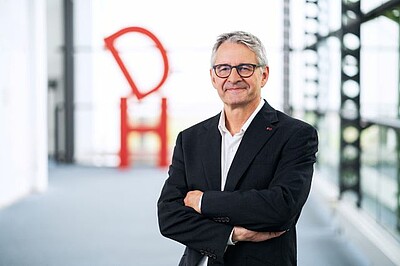Prof. Dr. Thomas Haalboom

Ausbildung
|
1987 ‑ 1994 |
Studium der Physik, Universität Karlsruhe (TH) Thema der Diplomarbeit: „Oberflächenbehandlung von Metallen und Gläsern und deren Reinigung mittels Excimerstrahlung“ |
|
1995 ‑ 1998 |
Promotion am Max-Planck-Institut für Metallforschung, Stuttgart Thema der Doktorarbeit: „Mikrostruktur und Konstitution von Cu-In-Se-Mischkristallen für Solarzellen" |
Berufliche Tätigkeiten
|
1998 ‑ 2000 |
Siemens AG, Bruchsal Fertigungs- und Prozessingenieur im Center of Manufacturing Technologies |
|
2000 ‑ 2001 |
Infineon Technologies AG, Regensburg Entwicklungsingenieur im Bereich Assembly and Interconnect |
|
2001 ‑ 2004 |
Robert Bosch GmbH, Reutlingen Entwicklungsingenieur im Sensortechnologiezentrum |
|
2004 ‑ 2011 |
Robert Bosch GmbH, Schwieberdingen Entwicklungsingenieur Engineering Assembly and Interconnect |
|
2011 ‑ 2019 |
Professor in der Fakultät für Technik, Studiengang Mechatronik |
|
2019 ‑ heute |
Studiengangsleiter Mechatronik |
Lehraufträge
|
1995 ‑ 2015 |
DRK Landesschule Baden-Württemberg, Dozent „Fachphysik für Rettungsassistenten“ |
|
2002 ‑ 2006 |
Lehrauftrag an der Hochschule Karlsruhe, Fachbereich Mechatronik und Naturwissenschaften |
Lehrgebiete
|
Aufbau- und Verbindungstechnik in der Elektronik Sensorik Fluidik Mathematik Mechatronische Systeme |
Preise und Auszeichnungen
|
2000 |
Werner-Köster-Preis |
|
2010 |
Deutscher Bürgerpreis |
Publikationen
-
(2023): Phase Equilibria of Cu-In-Se III. The In 2 Se 3 -Se-Cu 2 Se Subsystem. In: International Journal of Materials Research 91 (8), S. 651-662. DOI: 10.1515/ijmr-2000-910804
-
(2020): Aufbau einer Untersuchungseinrichtung für Bilche in freier Wildbahn und Erheben von Felddaten durch Sammeln von Urinproben. In: M A U S - Mitteilungen aus unserer Säugetierwelt (21), S. 20-32. Online verfügbar unter http://www.agws-bw.de/app/download/6705724/MAUS_21.pdf
-
(2018) : Towards a Stair Climbing Robot System Based on a Re-configurable Linkage Mechanism. Proceedings of the 15th International Conference IAS-15 In: Strand, Marcus; Dillmann, Rüdiger; Menegatti, Emanuele; Ghidoni, Stefano (Hg.): Intelligent Autonomous Systems 15: Proceedings of the 15th International Conference IAS-15: Springer International Publishing (Advances in Intelligent Systems and Computing), S. 278-288
-
(2017): „Thermal imaging of mammals“: Eignet sich Thermografie zum Aufspüren von Kleinsäugern in der Landschaft?. Erfahrungen und Experimente. In: M A U S - Mitteilungen aus unserer Säugetierwelt (20), S. 5-18. Online verfügbar unter www.agws-bw.de/app/download/6705724/Maus_20.pdf
-
(2016): Exploring the secrets of nest boxes: Opportunities and limits of video surveillance of nest cavities. In: Vogelwarte - Zeitschrift für Vogelkunde 54 (2), S. 125-136. Online verfügbar unter https://www.do-g.de/fileadmin/do-g_dokumente/Vogelwarte_54_2016-2.pdf
-
(2015): Mechatronics meets biology: experiences and first results with a multipurpose small mammal monitoring unit used in red squirrel habitats. In: Hystrix, the Italian Journal of Mammalogy 2015, S. 169-172. DOI: 10.4404/hystrix-26.2-11475
-
(2000): Phase equilibria of Cu-In-Se I. Stable states and nonequilibrium states of the In2Se3-Cu2Se subsystem. In: Zeitschrift für Metallkunde 91 (8), S. 622-634. Online verfügbar unter https://www.researchgate.net/publication/279555425_Phase_equilibria_of_Cu-In-Se_I_Stable_states_and_nonequilibrium_states_of_the_In2Se3-Cu2Se_subsystem
-
(2000): Phase equilibria of Cu-In-Se. II. The In-In(sub 2)Se(sub 3)-Cu(sub 2)Se-Cu subsystem. In: Zeitschrift für Metallkunde 91 (8), S. 651-662. Online verfügbar unter https://www.researchgate.net/publication/279555337_Phase_equilibria_of_Cu-In-Se_II_The_In-In2Se3-Cu2Se-Cu_subsystem
-
(2000): Phase equilibria of Cu-In-Se. III. The In(sub 2)Se(sub 3)-Se-Cu(sub 2)Se subsystem. In: Zeitschrift für Metallkunde. Online verfügbar unter https://www.researchgate.net/publication/298937054_Phase_equilibria_of_Cu-In-SeIII_The_In2Se3-Se-Cu2Se_subsystem
-
(1998): Phase relations and microstructure in bulk materials and thin films of the ternary system Cu-In-Se Ternary and Multinary Compounds. In: Conference Series - Institute of Physics 152, S. 249-252. Online verfügbar unter https://www.tib.eu/de/suchen/id/BLCP%3ACN024461866/Phase-relations-and-microstructure-in-bulk-materials/
-
(1998) : New aspects of phase segregation and junction formation in CuInSe2 In: IEEE: 1997 IEEE 26th Photovoltaic Specialists Conference: Conference Record of the Twenty Sixth IEEE Photovoltaic Specialists Conference - 1997: Anaheim, CA, USA: 29 Sept.-3 Oct. 1997. IEEE, Electron Devices Society Staff; IEEE, Institute of Electrical and Electronics Engineers, Inc. Staff: Piscataway
-
(1997) : Performance and Defects in Cu In Ga Se~2 Based Heterojunctions - Technische Informationsbibliothek (TIB): European photovoltaic solar energy conference, S. 1246-1249. Online verfügbar unter https://www.tib.eu/de/suchen/id/BLCP%3ACN023425280/Performance-and-Defects-in-Cu-In-Ga-Se~2-Based/
Patente
- Elektrische Vorrichtung mit einem Trägerelement mit zumindest einer speziellen Anschlussfläche und einem oberflächenmontierten Bauelement; Robert Bosch GmbH, 70469 Stuttgart, DE DE102006062494A1 03.07.2008
- Carrier system for a high-frequency antenna and method for its manufacture US020090015509A1 15.01.2009
Trägeranordnung für eine Hochfrequenzantenne und Verfahren zu ihrer Herstellung WO002006032579A1 30.03.2006 - Device for passivating at least one component by a housing and method for manufacturing a device, US020070279876A1 06.12.2007
- Elektronisches Bauelement auf einem Trägerelement, WO002005074337A1 11.08.2005
- Bauelementeträger, DE102004010292A1 29.09.2005
- Verfahren zum Verschweißen, DE000010256254A1 24.06.2004
- Elektronisches Bauteil mit wenigstens einem Halbleiterchip und Verfahren zu seiner Herstellung, DE000010201782A1 27.03.2003
